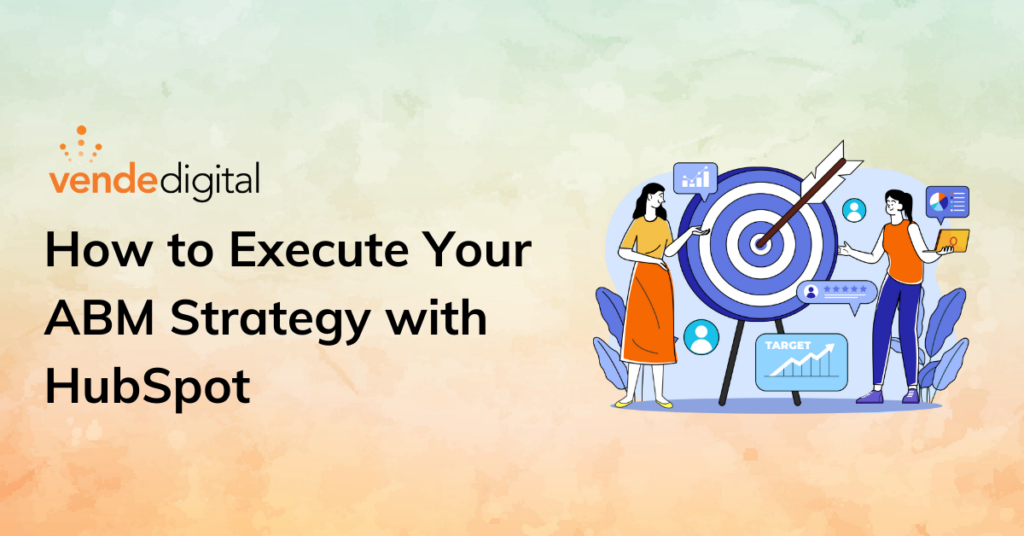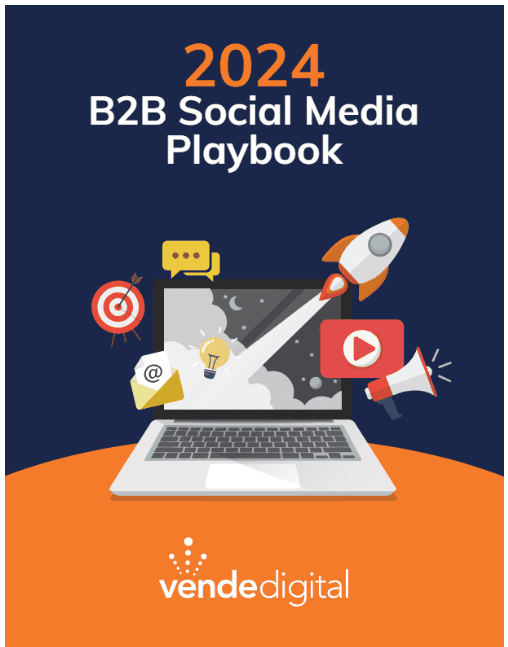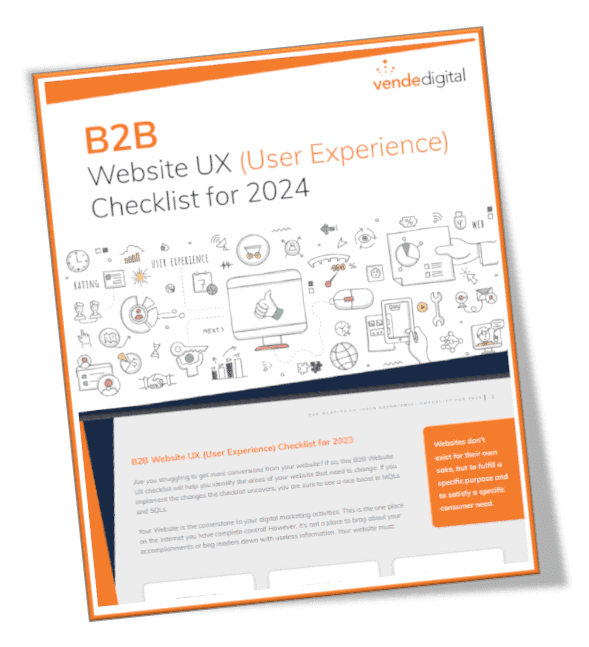
In our previous blog, we explored how to build a strong foundation for Account-Based Marketing (ABM) using HubSpot. Now that you’ve identified your target accounts, created coverage plans, and built content hubs, it’s time to execute your HubSpot ABM strategy and optimize for success.
Account-based marketing isn’t just about targeting the right accounts; it’s about engaging them effectively throughout their buyer’s journey. This is where HubSpot’s powerful suite of tools shines, enabling you to create personalized experiences, track buyer signals, and continuously refine your approach.
In this blog, we’ll dive deep into three crucial aspects of executing and optimizing your HubSpot ABM strategy:
- Building high-converting account-based marketing landing pages
- Running full-funnel promotional campaigns
- Harnessing buyer signals for proactive engagement
By the end of this post, you’ll have a comprehensive understanding of how to leverage HubSpot to take your account-based marketing efforts to the next level, driving meaningful engagement and conversions with your high-value accounts.
Get More ABM Tips and Best Practices in our ABM + Demand Gen Webinar Replay
While this blog series will focus primarily on leveraging HubSpot, you may want to check out our on-demand webinar on ABM + Demand Gen for a more comprehensive review of Account-Based Marketing (ABM) principles.
Step 1: Building High-Converting Account-Based Marketing Landing Pages
Your landing pages serve as the tipping point for converting target accounts. With HubSpot’s tools, you can design landing pages that are visually engaging and optimized for conversion. Let’s explore how to craft high-performing pages that align with your overall ABM strategy.
Key Elements of a Successful Account-Based Marketing Landing Page
- Relevant Topic/Offer: The first step in ensuring your landing page converts is offering a topic or offer that resonates with your target accounts. Visitors should immediately grasp the value of your offer. HubSpot’s A/B testing feature can be a powerful tool here—experiment with different headlines and value propositions to see what drives the best results. This relevance is key in grabbing attention and driving engagement.
- Personalization: HubSpot’s smart content capabilities allow you to tailor messaging based on visitor attributes like industry, company size, or even previous interactions. In the example above, the landing page is personalized with the visitor’s name, making the experience more relevant and increasing the likelihood of conversion.
- Progressive Fields: HubSpot’s form builder supports progressive profiling, allowing you to collect valuable information over time without overwhelming your visitors with too many fields. Start with basic information and gradually ask for more as the visitor interacts with your content, creating a seamless experience that encourages form completions.
- Compelling CTAs: Design action-oriented CTAs using strong, concise language. HubSpot’s CTA tool allows you to create smart CTAs that change based on visitor attributes or behavior, ensuring maximum relevance.
- Stage-Specific Offers: Align your landing page content with the specific stage of the buyer’s journey. The example above is for an educational webinar. This type of content might be more suitable for visitors in the awareness stage, while case studies or demo offers are ideal for those in the consideration stage. This strategic alignment ensures that your content meets the needs of your audience at the right time.
Engaging Design for Account-Based Marketing Landing Pages
- Visual Appeal: Your landing page’s design should reflect your brand’s identity while also being visually engaging. HubSpot’s drag-and-drop editor allows you to customize templates or create pages from scratch, ensuring your landing page aligns with your account-based marketing objectives.
- Form Integration and Placement: Seamlessly integrate forms into your landing pages using HubSpot’s form builder. In the example above, the form is clearly above the fold, making it easy for the user to convert.
- Mobile Optimization: With HubSpot’s responsive design features, ensure your landing page looks great on all devices. This is crucial as more B2B decision-makers access content on mobile devices.
A/B Testing and Optimization
- Test Variations: Leverage HubSpot’s A/B testing features to experiment with different headlines, CTAs, images, and layouts. This data-driven approach helps you determine what resonates best with your target accounts.
- Performance Tracking: Monitor key metrics such as conversion rates, bounce rates, and time on the page using HubSpot’s analytics tools. These insights help you understand how visitors are interacting with your landing page and where improvements can be made.
- Heat Maps: Use a heat mapping tool like HotJar to understand where visitors are most likely to engage with your page and place your CTAs accordingly.
- Continuous Improvement: Use the data collected from your analytics to continuously refine and improve your landing pages. Regularly update content, design, and CTAs based on performance insights to maximize conversions.
Pro Tip: Create account-specific landing pages for your top-tier account-based marketing targets. These hyper-personalized pages can significantly boost engagement and conversion rates.
Step 2: Running Full-Funnel Promotional Campaigns to Align Sales and Marketing Teams
Successful account-based marketing requires engaging target accounts at every stage of the buyer’s journey. Account-based marketing is one of the best ways to bring sales and marketing teams together. HubSpot’s powerful tools enable you to create awareness, nurture leads, and convert prospects into loyal customers. Let’s explore how to craft and run effective promotional campaigns that align with your account-based marketing strategy and drive superior results.
Top of Funnel: Creating Awareness with Target Accounts
As Part One of the blog series mentions, your Sales and Marketing teams need to come together to select and tier your target accounts. This will help you identify which department will lead the charge on which accounts. At this stage, your goal is to drive content consumption and attract target accounts to your site.
- Educational Content: Develop high-value content such as blog posts, infographics, and videos that address your target accounts’ pain points and interests. Use HubSpot’s content creation tools to produce and publish content that captures attention and builds brand awareness.
- SEO Optimization: Utilize HubSpot’s SEO tools to optimize your content for search engines. Identify relevant keywords and topics to ensure your content ranks well and attracts organic traffic from your target accounts.
- Social Content Calendar: Leverage HubSpot’s social media tools to schedule and publish posts promoting your educational content. The social media calendar feature allows you to maintain a consistent presence across platforms.
- Thought Leadership: Integrate key executives and subject matter experts into HubSpot’s social posting features. This allows them to share thought leadership content with their connections on LinkedIn and other platforms, expanding their reach to target accounts. You’ll also be able to monitor and analyze their performance along with your company’s posts.
Middle of Funnel: Educating Problem-Aware Prospects
At this stage, your prospects recognize they have a problem and are seeking information. Your goal is to educate them and offer clear paths forward.
- Segmented Email Campaigns: Use HubSpot’s segmentation features to create targeted email lists based on criteria such as industry, persona, and engagement history. Send personalized emails that address each segment’s specific needs and interests.
- Automated Workflows: Set up automated email workflows in HubSpot to nurture leads through the buyer’s journey. Design sequences that deliver relevant content and offer at the right time, ensuring continuous engagement and progression toward conversion.
- Event Invitations: Use HubSpot’s event management integration tools, such as Eventbrite or Goldcast, to invite target accounts to relevant webinars or virtual events. Offer personalized invitations that align with their specific needs and interests.
- Social Media Engagement: Use HubSpot’s social media monitoring tools to track mentions, comments, and interactions with target accounts. Engage in conversations, share valuable insights, and build relationships with your prospects.
Bottom of Funnel: Converting In-Market Key Accounts
At this stage, your prospects are actively evaluating solutions. Your goal is to convert them by offering compelling, personalized content and offers that address their specific needs.
- Personalized Outreach: Equip your sales team with personalized outreach templates and playbooks using HubSpot’s sales tools. Ensure they have access to relevant content and insights that can be used to engage and convert prospects.
- Integrated Communication: Leverage HubSpot’s CRM to track all interactions with prospects. This enables seamless communication between marketing and sales teams, ensuring a coordinated and consistent approach.
- Product Demos: Offer personalized product demos to high-intent prospects. Use HubSpot’s meeting scheduling tool to streamline the process and ensure timely follow-ups.
Leveraging Paid Campaigns for Account-Based Marketing
- Targeted Advertising: Utilize HubSpot’s Ads tool to run targeted campaigns that reach your key accounts across various channels. Use account-based targeting options, such as IP address targeting, to ensure your ads are seen by the right people.
- Retargeting: Implement retargeting campaigns to re-engage visitors who have previously interacted with your content or website. Use HubSpot’s tracking capabilities to show personalized ads that encourage them to return and take the next step in their journey.
- LinkedIn Advertising: LinkedIn offers multiple ad products to reach targeted audiences. Be sure to check out these resources for more information; What’s New and Winning in LinkedIn Advertising for 2024, LinkedIn Ads Clinic Demand Gen Jam Session Webinar
Optimizing Campaign Performance
- Lead Scoring: Use HubSpot’s lead scoring tools to track and score leads based on their interactions with your content, website, and emails. This helps prioritize high-intent leads and tailor your nurturing efforts accordingly.
- Campaign Analytics: Track the performance of your campaigns using HubSpot’s analytics tools. Monitor key metrics such as open rates, click-through rates, conversion rates, and ROI to gauge effectiveness.
- Data-Driven Optimization: Use the insights gathered from your analytics to make data-driven decisions. Continuously refine and optimize your campaigns based on performance data to achieve better results.
Pro Tip: Use HubSpot’s reporting tools to create a closed-loop reporting system between marketing and sales. This ensures both teams are aligned on what’s working and what needs improvement in your account-based marketing efforts.

Explore our B2B Social Media Playbook for guidance on engaging vital prospects on social media in each stage of the buying journey. This in-depth playbook guides the dynamic B2B social media marketing scene. Filled with practical insights, tested strategies, and tangible examples.
Step 3: Harnessing Buyer Signals for Proactive Engagement
As targeted buyers interact with your account-based marketing campaigns, they emit valuable signals indicating their interest and intent. HubSpot allows you to monitor these activities, alert your sales team, and deliver personalized follow-up sequences based on this behavior.
Identifying Key Buyer Signals
- Website Visits: When a targeted buyer frequently visits your website, it indicates heightened interest. This surge in activity is a strong signal that the buyer is progressing through their journey.
- Content Interaction: Engagement with specific content, such as downloading whitepapers, watching videos, or attending webinars, reveals the buyer’s interests and needs.
- Page Views: Monitoring which pages a buyer visits can offer insights into their pain points and solutions they’re considering.
- Form Submissions: When buyers fill out forms for gated content or demo requests, it’s a clear signal of their intent to learn more or engage further.
HubSpot Tools for Monitoring and Alerting
- Real-Time Alerts: Create automated alerts in HubSpot that notify your sales team when a high-intent buyer visits your website or engages with specific content. This ensures timely follow-ups and helps capitalize on engagement opportunities.
- Automated Workflows: Set up automated workflows in HubSpot to send targeted emails and other communications based on a buyer’s behavior. For example, if someone downloads an eBook, you can trigger a nurturing email sequence that provides more information about the topic.
- Chatbots: Use chatbots powered by HubSpot’s Conversations tool to engage buyers in real-time conversations based on their interactions with your content or website. These bots can gather valuable data and connect prospects with sales reps when appropriate.
- Custom Alerts: Set up custom alerts for specific actions, such as repeated visits to strategic content or high-value pages. These alerts ensure that your sales team can respond promptly to buyer signals.
Behavioral Tracking and Lead Scoring
- Comprehensive Tracking: HubSpot’s behavioral tracking tools monitor and record buyer interactions with your website, content, and emails. This data helps you understand a buyer’s interests, needs, and intent as they progress through the buyer’s journey.
- Advanced Lead Scoring: By integrating behavioral data into your lead scoring system, you can prioritize leads based on their level of engagement and interest. This ensures that your sales team focuses on high-intent prospects who are most likely to convert.
- CRM Integration: Seamlessly integrate tracking data with HubSpot CRM to comprehensively view buyer interactions across all touchpoints.
Optimizing Engagement and Conversion
- Personalized Outreach: Use the data gathered from buyer signals to tailor your follow-up sequences. Address the specific interests and pain points indicated by the buyer’s behavior.
- Dynamic Content: Leverage HubSpot’s dynamic content features in emails and landing pages to provide a personalized experience that resonates with the buyer based on their observed behavior and attributes.
- Continuous Refinement: Regularly analyze the performance of your engagement strategies and refine your approach based on what works best. Use HubSpot’s A/B testing capabilities to continually optimize your outreach methods.
Pro Tip: Set up a lead routing system in HubSpot that automatically assigns high-intent leads to the most appropriate sales rep based on factors like industry expertise or account history. This ensures that your most promising prospects receive timely, relevant follow-up.
Driving Account-Based Marketing Strategy Success with HubSpot
Executing and optimizing your ABM strategy with HubSpot empowers you to create highly personalized, data-driven campaigns that resonate with your key accounts. The key to long-term success in account-based marketing lies in continuous optimization. Regularly review your performance metrics, gather feedback from your sales team, and refine your strategies accordingly. With HubSpot’s analytics and reporting capabilities, you have the insights to make data-driven decisions that propel your account-based marketing efforts forward.
By embracing this approach, you’re not just implementing an account-based marketing strategy– you’re transforming how your organization engages with high-value accounts. This leads to stronger relationships, higher conversion rates, and, ultimately, sustained business growth.
Your journey to elevating your account-based marketing strategy is an ongoing refinement and optimization process. With HubSpot as your foundation, you’re well-equipped to navigate the complexities of modern B2B marketing and turn your target accounts into loyal, high-value customers.
Are you ready to take your ABM strategy to the next level with HubSpot? The path to more effective, personalized, and results-driven marketing starts here.
Key Takeaways on Executing Your HubSpot ABM Strategy
- Personalization is Paramount: Tailoring your content and messaging to your target accounts’ specific needs and behaviors is essential for driving engagement. Use HubSpot’s smart content and personalization tools to create relevant experiences that resonate with each account.
- Optimize Landing Pages for Conversion: High-converting Account-Based Marketing landing pages are crucial for turning interest into action. To maximize conversions, focus on relevant offers, personalized content, compelling CTAs, and strategically placed forms.
- Full-Funnel Engagement: Account-based marketing (ABM) success requires a coordinated approach across the buyer’s journey. From top-of-funnel awareness to bottom-of-funnel conversion, use HubSpot’s tools to create targeted, personalized campaigns that move prospects seamlessly through the funnel.
- Harness Buyer Signals: Monitor and respond to key buyer signals using HubSpot’s tracking and alert features. Real-time insights into buyer behavior allow you to engage proactively, ensuring timely follow-ups and increasing your chances of conversion.
- Continuous Improvement is Key: Account-based marketing is not a one-and-done effort. Regularly analyze performance data and refine your strategies based on insights gathered from HubSpot’s analytics and reporting tools. Continuous optimization ensures your account-based marketing efforts stay aligned with your goals and yield the best results.
Focusing on these key elements can help you effectively execute your ABM strategy with HubSpot, driving meaningful engagement with your high-value accounts and achieving sustained business growth.
Ready to Elevate Your ABM Strategy to the Next Level?
Now that you’ve unlocked the potential of executing a successful Account-Based Marketing (ABM) strategy with HubSpot, it’s time to implement these insights. Begin implementing these strategies today to engage your target accounts and drive meaningful results.
Need expert guidance to refine your account-based marketing approach? We’re here to help. Schedule a free consultation with our ABM specialists at Vende Digital. We’ll analyze your current strategy, identify opportunities for improvement, and deliver tailored recommendations to maximize your account-based marketing success with HubSpot.
